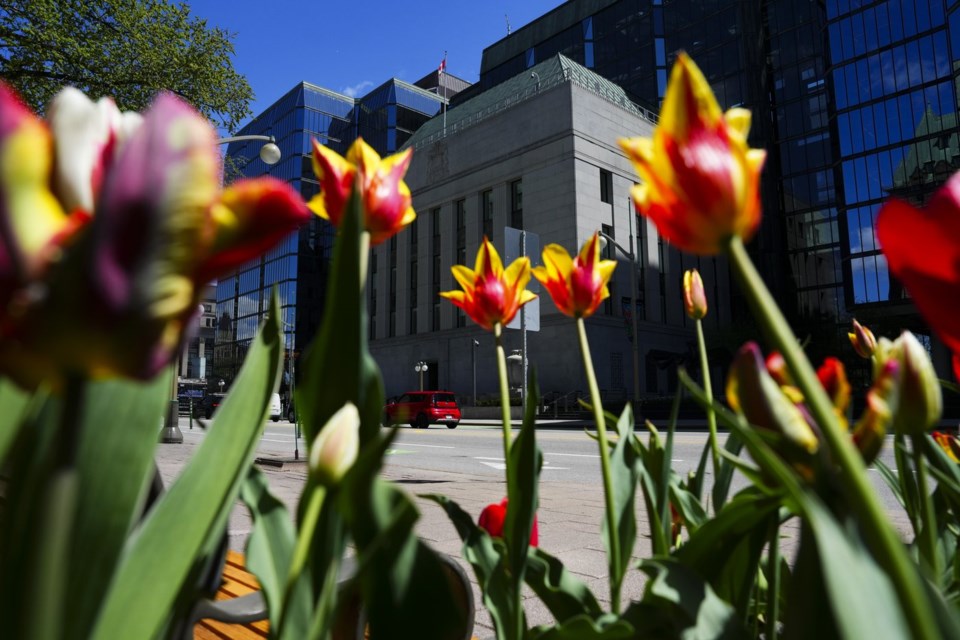OTTAWA — The Bank of saąúĽĘ´«Ă˝ marked a major turning point in its fight against inflation on Wednesday as it lowered its key interest rate for the first time in more than four years, making it the first central bank in the G7 to cut rates.
Governor Tiff Macklem said the central bank has more confidence inflation is moving closer to its two per cent target, citing various indicators that suggest price pressures have retreated.
"If inflation continues to ease, and our confidence that inflation is headed sustainably to the two per cent target continues to increase, it is reasonable to expect further cuts to our policy interest rate," Macklem said in remarks prepared for a morning news conference.
"But we are taking our interest rate decisions one meeting at a time."
With the quarter-percentage-point cut, the central bank’s key interest rate now stands at 4.75 per cent.
Macklem and senior deputy governor Carolyn Rogers delivered the news while wearing Edmonton Oilers pins, a nod to the Canadian hockey team heading to the NHL finals later this week. Like the Oilers' ascent to the Stanley Cup finals, the Bank of saąúĽĘ´«Ă˝'s rate cut has given Canadians something to cheer for.
While the Wednesday rate cut opened a new chapter for the Bank of saąúĽĘ´«Ă˝, the governor faced questions about whether the central bank would cut again at its July meeting. Macklem urged the room of reporters to be patient.
"Let's enjoy the moment," he said.
Meanwhile on Parliament Hill, federal Liberals celebrated the news.
After attending the Liberals' weekly caucus meeting, Finance Minister Chrystia Freeland took the microphone to echo Macklem's comments that the rate cut was a moment to enjoy.
"saąúĽĘ´«Ă˝ is the first G7 country where interest rates have been lowered. Our economic plan is working and that is really welcome news for saąúĽĘ´«Ă˝ and Canadians," she said.
Conservatives, on the other hand, were in no celebratory mood as they argued the rate cut would do little to help Canadians.
"The NDP-Liberal government cannot declare victory as a result of this tiny rate cut because millions of Canadians continue to suffer as a result of their policies," Tories said in a news release.
"This rate cut is not a mark of success for Justin Trudeau but rather a reminder that millions of Canadians will be forced to renew their mortgages at much higher rates thanks to his inflationary policies."
With inflation down significantly and the economy stalling, most forecasters believed it was the right time for the central bank to begin lowering borrowing rates.
"This was largely as expected, but I must say, it was not a certainty by any means that the Bank of saąúĽĘ´«Ă˝ was going to cut," said Douglas Porter, BMO's chief economist.
"This is, after all, the first time that the bank has cut with Mr. Macklem as governor."
Although the governor didn't speculate on what the Bank of saąúĽĘ´«Ă˝ might do at its next rate decision, Porter took his comments as a sign the central bank may cut again in July.
"What surprised me is that they very clearly have left the door open for a possible follow-up rate cut in July, a little bit more open than I would have assumed," he said.
The Bank of saąúĽĘ´«Ă˝ will have inflation data for both May and June to consider before its next interest rate decision scheduled for July 24.
saąúĽĘ´«Ă˝'s annual inflation rate has steadily declined in recent months, reaching 2.7 per cent in April.
The Canadian economy has also weakened under the weight of high interest rates. Economic growth in the first quarter came in lower than forecasters expected, and the unemployment rate has steadily risen, reaching 6.1 per cent in April.
A quarter-percentage-point rate cut won't turn things around for the economy on its own, but TD's director of economics, James Orlando, said it paves the way for more rate cuts in the coming months.
"It's the start of what's likely going to be an easing cycle for the Bank of saąúĽĘ´«Ă˝. So it's not just about today's cut," Orlando said.
TD expects the Bank of saąúĽĘ´«Ă˝ to lower its key interest rate to 4.25 per cent by the end of the year.
The rate decision puts the Bank of saąúĽĘ´«Ă˝ ahead of other central banks in the Western world in cutting interest rates, including the U.S. Federal Reserve.
When asked how much the Bank of saąúĽĘ´«Ă˝ can diverge from its peers, Macklem said that it doesn't need to walk in lockstep with the Fed.
"There are limits to how far we can diverge from the United States, but we're not close to those limits."
This report by The Canadian Press was first published June 5, 2024.
Nojoud Al Mallees, The Canadian Press



